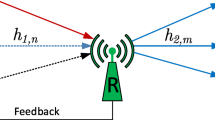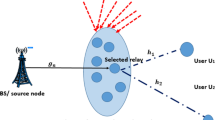Abstract
In this paper, a combination system of multi-antenna multiple input multiple output (MIMO) and non-orthogonal multiple access (NOMA) technologies is investigated, in which the source communicates with users using a multiple amplify-and-forward (AF) relaying network. These relay nodes are equipped with a single antenna and employ a power-splitting protocol to harvest energy from received signals, whereas the source and users are multiple-antenna nodes. In addition, two antenna-relay selection methods are considered to enhance the harvested energy at the relay including the maximum ratio transmission (MRT) and transmit antenna selection (TAS) at the source, with maximal-ratio combining at the users, these methods are compared to the performance of the random selection (RS) scheme. To evaluate the performance of the proposed system, we derive analytical expressions of the outage probability and throughput for the MRT and TAS schemes over Rayleigh fading channels, and use a Monte Carlo simulation to verify the accuracy of the analytical results. The results demonstrate the benefit of using MRT and TAS schemes, which provide a better performance than RS schemes, in a MIMO/NOMA system. Moreover, these results characterize the effects of various system parameters, such as power allocation factors, the numbers of antenna and relay nodes, power-splitting ratio, successive interference cancellation and energy-harvesting efficiency, on the system performance of two users of MIMO/NOMA. This is further compared with multiple-antenna conventional orthogonal multiple access (MIMO/OMA) schemes.







Similar content being viewed by others
Notes
In this paper, we assumed that the EH relaying network as linear model (in assumption (vi)), thus, the conversion efficiency is a constant. For the non-linear EH model, \(\mu \) is a function of the input RF power and the output direct current power [30].
References
Ding, Z., Liu, Y., Choi, J., Sun, Q., & Elkashlan, M. (2017). Application of non-orthogonal multiple access in LTE and 5G networks. IEEE Communications Magazine, 55, 185–191.
Islam, R., Avazov, N., & Dobre, O. A. (2017). Power-domain non-orthogonal multiple access (NOMA) in 5G systems: Potentials and challenges. IEEE Communications Surveys and Tutorials, 19, 721–742.
Dai, L., Wang, B., Yuan, Y., Han, S., Chih-Lin, I., & Wang, Z. (2015). Non-orthogonal multiple access for 5G: Solutions, challenges, opportunities, and future research trends. IEEE Communications Magazine, 53(9), 74–81.
Ding, Z., Lei, X., Karagiannidis, G. K., Schober, R., Yuan, J., & Bhargava, V. K. (2017). A survey on non-orthogonal multiple access for 5G networks: Research challenges and future trends. IEEE Journal on Selected Areas in Communications, 35, 2181–2195.
Ding, Z., Peng, M., & Poor, H. V. (2015). Cooperative non-orthogonal multiple access in 5G systems. IEEE Communication Letters, 19(8), 1462–1465.
Ding, Z., Fan, P., & Poor, H. V. (2015). On the impact of user pairing on NOMA. In IEEE TVT.
Mohammadi, M., Chalise, B. K., Hakimi, A., Mobini, Z., Suraweera, H. A., & Ding, Z. (2018). Beamforming design and power allocation for full-duplex non-orthogonal multiple access cognitive relaying. IEEE Transactions on Communications, 66, 5952–5965.
Ding, Z., Adachi, F., & Poor, H. V. (2016). The application of MIMO to non-orthogonal multiple access. IEEE Transactions on Wireless Communications, 15(1), 537–552.
Liu, Y., Pan, G., Zhang, H., & Song, M. (2016). On the capacity comparison between MIMO-NOMA and MIMO-OMA. IEEE Accesss, 4, 2123–2129.
Huang, Y., Zhang, C., Wang, J., Jing, Y., Yang, L., & You, X. (2018). Signal processing for MIMO-NOMA: Present and future challenges. arXiv:1802.00754.
Paradiso, J. A., & Starner, T. (2005). Energy scavenging for mobile and wireless electronics. IEEE Pervasive Computing, 4, 18–27.
Varshney, L. R. (2008). Transporting information and energy simultaneously. In Information Theory, ISIT 2008 (pp. 1612–1616).
Nasir, A. A., & Durrani, S. (2013). Relaying protocols for wireless energy harvesting and information processing. IEEE Transactions on Wireless Communications, 12(7), 3622–3636.
Di, X., Xiong, K., Fan, P., & Yang, H. (2014). Simultaneous wireless information and power transfer in cooperative relay networks with rateless codes. IEEE Transactions on Vehicular Technology, 66(4), 2981–2996.
Zhou, X., Zhang, R., & Ho, C. K. (2014). Wireless information and power transfer in multiuser OFDM systems. IEEE Transactions on Wireless Communications, 13(4), 2282–2294.
Zhang, R., & Ho, C. K. (2012). MIMO broadcasting for simultaneous wireless information and power transfer. IEEE Transactions on Wireless Communications, 12(5), 1989–2001.
Liu, Y., Ding, Z., Elkashlan, M., & Poor, H. V. (2016). Cooperative non-orthogonal multiple access with simultaneous wireless information and power transfer. IEEE Journal on Selected Areas in Communications, 34, 938–953.
Han, W., Ge, J., & Men, J. (2016). Performance analysis for NOMA energy harvesting relaying networks with transmit antenna selection and maximal-ratio combining over Nakagami-m fading. IET Communications, 10, 2687–2693.
Fan, L., Zhao, N., Lei, X., Chen, Q., Yang, N., & Karagiannidis, G. K. (2018). Outage probability and optimal cache placement for multiple amplify-and-forward relay networks. IEEE Transaction on Vehicular Technology, 67(12), 12373–12378.
Lao, X., Fan, L., Lei, X., Li, J., Yang, N., & Karagiannidis, G. K. (2019). Distributed secure switch-and-stay combining over correlated fading channels. IEEE Transaction on Information Forensics and Security, pp(99), 1–10.
Ding, Z., Dai, H., & Poor, H. V. (2016). Relay selection for cooperative NOMA. IEEE Wireless Communications Letters, 5(4), 416–419.
Mobini, Z., Mohammadi, M., Suraweera, H. A., & Ding, Z. (2017). Full-duplex multi-antenna relay assisted cooperative non-orthogonal multiple access. In Proceedings of IEEE Global Communications Conference (GLOBECOM 2017), Singapore (pp. 1–7).
Mohammadi, M., Mobini, Z., Suraweera, H. A., & Ding, Z. (2018). Antenna selection in full-duplex cooperative NOMA systems. In Proceedings of IEEE International Conference on Communications (ICC 2018), Kansas City, MO, USA (pp. 1–6).
Ikki, S., & Ahmed, M. (2010). On the performance of cooperative-diversity networks with the Nth best relay selection scheme. IEEE Transactions on Wireless Communications, 58, 3062–3069.
Khafagy, M., Ismail, A., Alouini, M. S., & Assa, S. (2015). Efficient cooperative protocols for full-duplex relaying over Nakagami-m fading channels. IEEE Transactions on Wireless Communications, 14, 3456–3470.
Ding, H., Ge, J., da Costa, D. B., et al. (2011). Asymptotic analysis of cooperative diversity systems with relay selection in a spectrum-sharing scenario. IEEE Transactions on Vehicular Technology, 60, 457–472.
Tse, D., & Viswanath, P. (2004). Fundamentals of wireless communication. Cambridge University Press
Gradshteyn, I. S., & Ryzhik, I. M. (2014). Table of intergrals, series, and products (8th ed.). New York: Academic Press.
Olver, F. W. J., Lozier, D. W., Boisvert, R. F., & Clark, C. W. (2010). NIST handbook of mathematical functions. New York: Cambridge University Press.
Valenta, C., & Durgin, G. (2014). Harvesting wireless power: Survey of energy-harvester conversion efficiency in far-field, wireless power transfer systems. IEEE Microwave Magazine, 15(4), 108–120.
Acknowledgements
This work was supported by the 2020 Research Fund of the University of Ulsan.
Author information
Authors and Affiliations
Corresponding author
Additional information
Publisher's Note
Springer Nature remains neutral with regard to jurisdictional claims in published maps and institutional affiliations.
Appendices
Appendix 1: Proof of Theorem 1
In MRT schemes, by substituting (2b) and (3a) into (19), equation in (19) can be expressed as
Applying equation [29, Eq. 26.4.10] we have
where the summation is over all nonnegative integers \({n_1},{n_2},\ldots ,{n_k}\) , such that \({n_1} + {n_2} +\cdots + {n_k} = n\) ; the \(OP_1\) in MTR scheme in (28) can be formulated as
Here, \({n_0} + {n_1} +\cdots + {n_{{N_0}}} = K - 1\).
Applying the Newton binomial \({\left( {a + b} \right) ^k} = \sum \nolimits _{i = 0}^k {\left( \begin{array}{l} k\\ i \end{array} \right) } {a^{k - i}}{b^i}\) , (30) can be expressed as
By considering [28, Eq. (3.471.9)] as \({\int \nolimits _0^\infty {{x^{v - 1}}{e^{ - \frac{\beta }{x} - \gamma x}}dx = 2\left( {\frac{\beta }{\gamma }} \right) } ^{\frac{v}{2}}}{K_v}\left( {2\sqrt{\beta \gamma } } \right) \), we obtain \(OP_1^{MRT}\) as in (20).
In TAS schemes, by substituting (2b) and (4b) into (19), equation in (19) can be expressed as
Applying the Newton binomial and using [28, Eq. (3.471.9)], we obtain \(OP_1^{T{{AS}}}\) as in (21).
In RS schemes, by substituting (2b) and the PDF of X as \({f_{{g_{m,k,i}}}}\left( x \right) = {e^{ - \frac{x}{{{\lambda _m}}}}}/{\lambda _m}\) in (19), we can formulate (19) as
By using [28, Eq. (3.471.9)] as \({\int \nolimits _0^\infty {{x^{v - 1}}{e^{ - \frac{\beta }{x} - \gamma x}}dx = 2\left( {\frac{\beta }{\gamma }} \right) } ^{\frac{v}{2}}}{K_v}\left( {2\sqrt{\beta \gamma } } \right) \) , we obtain \(OP_1^{RS}\) as in (22).
This ends the Proof of Theorem 1.
Appendix 2: Proof of Theorem 2
Similar to formulating the outage probability at \(U_1\), the OP at \(U_2\) in three MRT, TAS and RS schemes can be obtained, as in (24), (25) and (26), respectively. This ends the Proof of Theorem 2.
Rights and permissions
About this article
Cite this article
Le, T.A., Kong, H.Y. Energy harvesting relay-antenna selection in cooperative MIMO/NOMA network over Rayleigh fading. Wireless Netw 26, 2075–2087 (2020). https://doi.org/10.1007/s11276-019-02051-1
Published:
Issue Date:
DOI: https://doi.org/10.1007/s11276-019-02051-1




